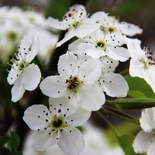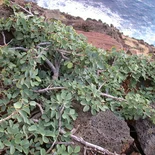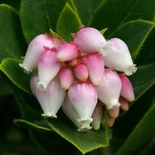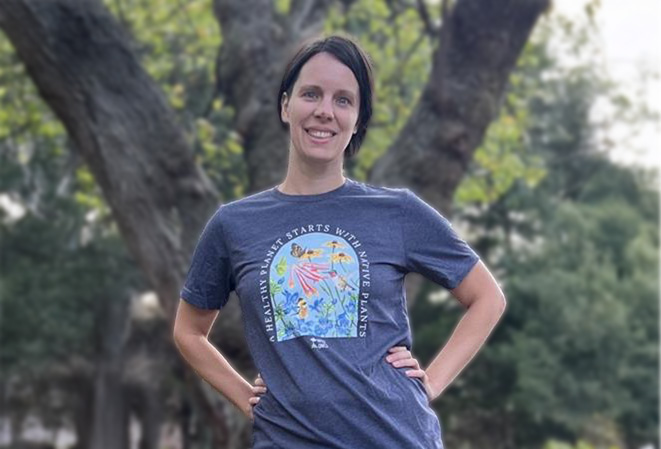At Wild Ones, we’re dedicated to connecting people and native plants. Our Native Plant News blog delivers the latest stories on native plant conservation, scientific discoveries, and habitat restoration from across the nation. This monthly, volunteer-written, feature is designed to educate, engage, and inspire action—empowering readers to support biodiversity and promote sustainable landscaping with native flora.
Missouri: Spring’s Stinky Scourge
It’s spring and the invasive non-native Bradford pear tree’s stench is in the air, prompting local organizations to push their annual efforts to get rid of the stink.

Callery Pear(Pyrus calleryana)
The Callery pear (Pyrus calleryana) and its cultivar, the Bradford pear tree, became popular in the United States when developers and landscapers were looking for trees to decorate suburban streets with small trees with pretty spring flowers and autumn color. While originally these trees were thought to be sterile, as people planted more varieties, the trees cross-pollinated with each other and escaped captivity. “They grow so vigorously, and they can grow anywhere, that they’re pushing out our native plants, which are displacing some of our wildlife species as well,” Billy Haag, forestry manager and certified arborist at Forest ReLeaf of Missouri, said. Additionally, these trees are not as strong as native trees and their V-like shape makes them prone to breakage making them a hazard to property.
Missouri has a solution: if Missourians prove that they removed a Callery pear from their property by mid-April, they can get a free native tree through a buyback program sponsored by the Missouri Invasive Plant Council, Forest ReLeaf of Missouri, Forrest Keeling Nursery and the Missouri Department of Conservation. Last year, the free native trees were claimed within 48 hours. There is also a bill in the Missouri legislature to prohibit the sale of Callery pears and several other non-native invasive species.
Get rid of a stinky Bradford pear tree, get a free Missouri native tree – StLPR.org
Hawaii: The Amazing Story of the Ka Palupalu o Kanaloa
There are only 20 Ka Palupalu o Kanaloa (Kanaloa kahoolawensis) left and the kapalupaluokanaloa.org website was created to educate on the story of, and efforts to conserve, the critically endangered Nawaiian plant, a plant thought extinct until rediscovered in 1992.

Kanaloa(Kanaloa kahoolawensis)
The Ka Palupalu o Kanaloa disappeared from pollen records around the 16th century. The plant’s genus was unknown to botanists until the species was rediscovered on Kahoʻolawe by Ken Wood and Steve Perlman of the National Tropical Botanical Garden and matched with unidentified fossil pollen. Found on Kahoʻolawe, an island that was used for bombing practice by the U.S. Armed Forces and is still in recovery ecologically, its rediscovery is even more astounding.
The efforts to propagate Ka Palupalu o Kanaloa have been difficult. In 2015, the two wild plants died and in 2020, only two plants remained in cultivation. Fortunately, both plants bloomed at the same time with one plant producing seeds. Now, the total population is at 20 plants thanks to efforts from Ka Palupalu o Kanaloa Hui and other organizations.
According to the Hawai’i Department of Land and Natural Resources, both the amazing endurance and resilience of this plant have special significance for Native Hawaiians, as Kahoʻolawe is a kino, or sacred form, of Kanaloa, the Hawaiian god of the ocean and marine life.
Extremely rare native Hawaiian plant finds success in cultivation – MauiNews.com
Texas: The Perfect Partnership
No longer will commercial nurseries and chain stores be a source of disappointment for Texas native plant enthusiasts. The largest independent grocery store chain, H-E-B, is partnering with the Native Plant Society of Texas (NPSOT) to offer customers a selection of native plants at its stores. This collaboration, started in fall of 2023 now includes a spring plant sale at more than 200 of the H-E-B’s 360 stores in Texas and will be distributing 24 species grown by Spring Creek Growers based Magnolia, Texas.
“Over 300,000 native plants will be headed to Texas homes,” said Anahi Villarruel, the project manager in H-E-B’s environmental affairs department overseeing the native plant initiative. She added that the species were selected with NPSOT to match different ecozones throughout the state. Having these plants displayed at the entrance of H-E-B’s stores while customers are there to shop will expose even more gardeners to native plants and why they should be utilized.
“The extreme weather conditions of the past few years have really underscored the value of native plants that evolved under Texas tough conditions,” Karen Guz, Vice-President of conservation at SAWS, San Antonio’s municipally owned water utility, said.
The Earth is Drying
According to a 2024 United Nations report, over the last 30 years, ¾ of the world’s land is becoming drier as the Earth’s average temperatures climb. This drying is currently occurring in the western United States, Brazil, most of Europe, Asia, and central Africa. The number of people living in drying lands has increased to 2.3 billion, over 25% of the population. If trends continue, 3% more land in more regions will become dry by 2100, crop yields will decrease, and the frequency of dust storms, and mass human migration from now-uninhabitable lands will increase.
What is causing globally drier conditions? Many factors are to blame. Climate change is a culprit: drought occurrence has risen 29% since 2000. Overgrazing, tilling, deforestation, and fertilizer/pesticide overuse leaves the land barren, unable to retain moisture, and prone to erosion: over 24 billion tons of fertile soil is lost every year. Overextraction of water from aquifers for agriculture and urbanization also contribute to drying and desertification.
Can the drying and desertification be reversed? Several examples are a beacon of hope. China’s Loess Plateau was restored from a barren wasteland due to unsustainable overuse by planting trees and grasses, terracing hillsides, and constructing dams to slow water flow to reduce erosion and restore water resources. Bolivia’s Altiplano had been degraded through overgrazing and poor land management. After planting native grasses, building dams, and employing rotational grazing, this land is back in use and enhancing the lives of locals. By planting trees, Africa’s Great Green Wall program restored 30 million hectares of land that had been previously degraded due to drought, deforestation, and overgrazing. Cities across the world are employing Akira Miyawaki’s miniforest idea, planting native plants very densely which causes them to grow quickly to compete for sunlight. These miniforests sequester carbon, restore soils, improve groundwater, decrease urban temperatures, and increase biodiversity.
From these real-world restoration efforts, experts suggest the best way to combat these drying and desertification trends is by planting native trees and plants and conserving water through drip irrigation, removing invasive species, rainwater harvesting, and terracing lands. Sustainable and regenerative agriculture practices are important to improve soil and biodiversity and to sequester carbon. Working with local people to employ traditional methods is valuable and governments, private investors, local communications, and organizations need to all be involved for maximum effect.
The Earth Is Getting Drier – State of the Planet
Oregon: Bees, Biking, and Beauty!
Portland Beecycle is an annual event for bicyclists to help plant native plants in parking strips. Created by Kim Brown with the Oregon Bee Atlas and Native Plant Society of Oregon, the goal was to create more native plant landscapes, increase habitat for pollinators and wildlife, and construct a beautiful garden for those in need. Each year, homeowners apply to have their parking strip planted. Brown selects 2-3 applicants, ensures the location is in a safe location for cyclists to work at, develops the plant list and design, and fundraises for seeds, plants, and supplies.
Partners with Portland Beecycle include Oregon Native Plant Society, Twinflower Natives, Portland State University’s Rae Selling Berry Seed Bank, and Friends of Backyard Habitat. The event has grown to include hundreds of plants and Brown is hoping to find cyclists with cargo bikes to join in. Porlanders interested in participating in the September events can follow @PortlandBeecycle on Instagram to be updated about 2025 events.
Portland ecologist mixes passion for plants, pollinators, and pedaling – BikePortland
California: A New Manzanita Species
A new species of manzanita shrub (Arctostaphylos nipumu) has been discovered along the central coast of California and its survival is already tenuous. Named after the Nipomo Mesa, where it was found and to honor its Indigenous heritage, this species has shaggy gray bark, which is different from most manzanita species.
More than 60 manzanita species are native to California. Evolving in a wildfire-prone climate, the waxy leaves minimize water loss and deep roots allow the plant to access water even during long droughts. The plant doesn’t resprout after fire; instead, their seeds require fire to germinate. These plants are an important source of food and habitat for wildlife and played an enormous role in Indigenous culture.

Manzanita(Arctostaphylos spp.)
Found in an already urbanized location, A. nipumu is already under threat due to urban expansion. The plant’s inability to resprout after wildfire makes its future even more uncertain. Local officials have been alerted to the plant’s presence and experts warn about the ecological significance of Nipomo Mesa and how difficult it is to reintroduce native species due to loss of genetic diversity in nursery stock.
Urban growth threatens newly discovered manzanita species – Earth.com
U.S. Butterfly Populations Decrease by 22%
A study published in the journal Science March 6th found that between the years 2000 to 2020, the total butterfly population across the United States fell by 22%.
While the monarch butterfly’s decline has been documented since the 1990’s, this study documented butterfly populations as a whole and both researchers and community volunteers collected data. Overall, the study found 33% of species had statistically significant population declines. Only 9 species (3% of the total species observed) had increasing populations. More than 100 species declined by over 50% and 22 species populations fell by at least 90 percent.
Some of the most impacted species include the Mitchell’s satyr (Neonympha mitchellii), the painted crescent (Phyciodes picta), and the Florida white (Appias drusilla). Even the invasive non-native cabbage white (Pieris rapae) populations dropped by 50%.
While the reason why was not discussed in the study, authors believe climate change, habitat loss, and insecticide are the likely reasons for the population declines. The Southwest saw the largest butterfly population declines: this was likely due to drought. These findings coincide with global trends of insect populations: more than 40% of insect species are declining.
Eliza Grames, one of the study’s authors, suggests that growing native plants in your backyard and supporting conservation policies are ways that people can help butterflies and other insect species. “Butterflies can recover quickly, because they have short generation times. Small actions like planting wildflowers, reducing pesticide use or even leaving part of a backyard unmowed can significantly improve their chances. Insects are fundamental to life on Earth, and we need conservation actions and policies that support insects.”
U.S. Butterflies Are Disappearing at Drastic Rates, With One in Five Gone Since 2000 – Smithsonian

